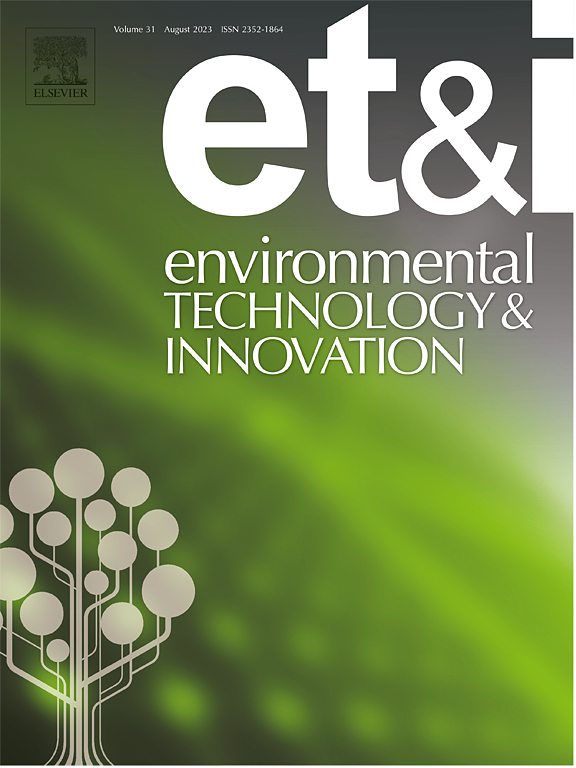氨转运体AmtB对于光养重氮单胞菌Rhodopseudomonas palustris吸收氨是不可或缺的
IF 6.7
2区 环境科学与生态学
Q1 BIOTECHNOLOGY & APPLIED MICROBIOLOGY
引用次数: 0
摘要
铵(NH4+)跨细胞膜转运在同化或清除环境氮方面发挥着重要作用。膜蛋白 AmtB 被认为是负责 NH4+ 吸收的 NH4+ 转运体。携带两个 AmtB 基因的光养重氮单胞菌(Rhodopseudomonas palustris)已被广泛用于废水处理和生物修复。然而,AmtB 在 R. palustris 中吸收 NH4+ 的作用仍不清楚。在这里,我们采用了一种创新的方法,将稳定同位素探测(SIP)与拉曼光谱相结合,以确定棕榈蛙体内 AmtB1 和 AmtB2 的生理功能。这种强大的技术使我们能够在单细胞水平上研究 NH4+ 的吸收。所生成的缺乏 AmtB1 和 AmtB2 蛋白的 R. palustris ΔamtB1 ΔamtB2 突变体在 15NH4+ 浓度低至 5 μM 时仍能利用 15NH4+。这些数据表明,无论环境中的 NH4+ 水平如何,这两种 AmtB 蛋白都不是 R. palustris 吸收 NH4+ 的必要条件。然而,在氮限制条件下,AmtB1 和 AmtB2 都能促进 NH4+ 的吸收。鉴于 R. palustris 在这些条件下主要表达 AmtB2,因此与 AmtB1 相比,AmtB2 在 NH4+ 吸收中发挥着更重要的作用。此外,转录组分析表明,删除 amtB1 和 amtB2 基因会导致许多转运体基因上调,这为今后研究替代 NH4+ 吸收系统提供了潜在目标。本文章由计算机程序翻译,如有差异,请以英文原文为准。
The ammonium transporter AmtB is dispensable for the uptake of ammonium in the phototrophic diazotroph Rhodopseudomonas palustris
Ammonium (NH4+) transport across cell membranes plays an important role in assimilation or removal of the environmental nitrogen. The membrane protein AmtB has been considered to be the NH4+ transporter that is responsible for the NH4+ uptake. The phototrophic diazotroph Rhodopseudomonas palustris harboring two amtB genes has been widely used in wastewater treatment and bioremediation. However, the role of AmtB in NH4+ uptake remains unclear in R. palustris. Here, we employed an innovative approach combining stable isotope probing (SIP) with Raman spectroscopy to determine the physiological functions of AmtB1 and AmtB2 in R. palustris. This powerful technique allowed us to investigate NH4+ uptake at the single-cell level. The generated R. palustris ΔamtB1 ΔamtB2 mutant lacking AmtB1 and AmtB2 proteins was still capable of utilizing 15NH4+ even the 15NH4+ concentration was as low as 5 μM. These data demonstrate that both of the AmtB proteins are not essential for R. palustris to take up NH4+ regardless of environmental NH4+ levels. However, both AmtB1 and AmtB2 can contribute to NH4+ uptake under nitrogen-limiting conditions. Given that R. palustris primarily expresses AmtB2 in these conditions, AmtB2 plays a more important role in NH4+ uptake compared to AmtB1. In addition, transcriptomic analysis showed that the deletion of the amtB1 and amtB2 genes resulted in the upregulation of many transporter genes, providing potential targets for future investigation of alternative NH4+ uptake systems.
求助全文
通过发布文献求助,成功后即可免费获取论文全文。
去求助
来源期刊

Environmental Technology & Innovation
Environmental Science-General Environmental Science
CiteScore
14.00
自引率
4.20%
发文量
435
审稿时长
74 days
期刊介绍:
Environmental Technology & Innovation adopts a challenge-oriented approach to solutions by integrating natural sciences to promote a sustainable future. The journal aims to foster the creation and development of innovative products, technologies, and ideas that enhance the environment, with impacts across soil, air, water, and food in rural and urban areas.
As a platform for disseminating scientific evidence for environmental protection and sustainable development, the journal emphasizes fundamental science, methodologies, tools, techniques, and policy considerations. It emphasizes the importance of science and technology in environmental benefits, including smarter, cleaner technologies for environmental protection, more efficient resource processing methods, and the evidence supporting their effectiveness.
 求助内容:
求助内容: 应助结果提醒方式:
应助结果提醒方式:


